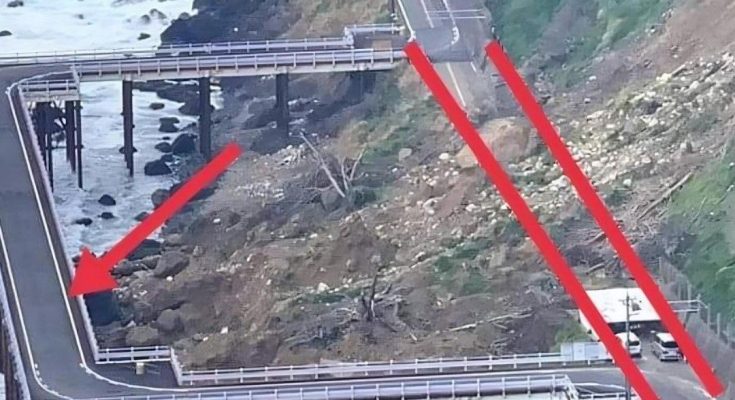When you come across a bridge that doesn’t follow a straight path, you might wonder why engineers chose a curved or angled design instead. Wouldn’t a straight bridge be simpler and more efficient? It turns out, bridge design is far from random; there are compelling reasons why some bridges veer off the straight path. Let’s dive into why engineers build bridges with curves and how these designs protect against natural forces, such as landslides.
The Importance of Bridge Design: More Than Just Aesthetics

At first glance, a curved bridge might seem like an architectural choice to make it more visually appealing. While aesthetics are sometimes a factor, the primary reasons are rooted in practicality and safety. Engineers consider various elements, such as the landscape, environmental threats, and structural integrity. In many cases, a curved or angled bridge can provide enhanced durability, reduced environmental impact, and greater resilience against natural forces.
One significant reason for curved bridge designs? Landslide prevention. But how does a bridge’s shape relate to landslides, and why would engineers avoid a straight path when constructing a bridge? Let’s break it down.
How Landslides Influence Bridge Design
Landslides are a natural hazard that can cause devastating damage to infrastructure. In regions prone to landslides, straight bridge designs may not be the safest option. A landslide can exert massive forces on a bridge, and if it impacts the structure at the wrong angle, it could lead to catastrophic failures.
By incorporating curves or angles, engineers can design bridges that are better equipped to handle or avoid the impact of landslides. Curved bridges allow for the following benefits in landslide-prone areas:
- Redirecting Force: A curved bridge can help redirect the force of a landslide away from the structure. Instead of the force hitting a straight line and potentially causing a collapse, a curve can help the energy disperse, minimizing the impact on the bridge.
- Avoiding Unstable Ground: Straight bridges may cross over areas that are highly susceptible to landslides. By curving the bridge, engineers can direct it around these hazardous areas, placing the structure on more stable ground and reducing the risk of landslide damage.
- Better Weight Distribution: Curved bridges can spread the load across multiple points, helping the bridge withstand any sudden forces from a landslide. This design feature enhances stability and reduces the strain on any single point of the structure.
Curved Bridges and Natural Terrain: Working with the Landscape
In many cases, engineers choose a curved bridge design to follow the natural contours of the land. This approach has numerous benefits, including minimizing environmental disruption and aligning the bridge with the landscape’s natural flow. Here’s how building with the terrain helps:
- Preserving the Environment: When a bridge is built in harmony with the natural landscape, there is less need for extensive excavation, which can harm local ecosystems. By curving around hillsides or valleys, bridges avoid cutting through critical habitats, helping to protect wildlife and maintain the area’s natural beauty.
- Reducing Erosion: Straight bridges may require significant land alteration, which can lead to erosion over time. Curved bridges, on the other hand, can adapt to the land’s natural features, reducing the need for ground modifications and minimizing erosion risks.
- Enhanced Stability: Building a bridge on stable, unaltered ground is safer and more economical. Curved bridges allow engineers to avoid unstable soil, such as areas prone to landslides, ensuring a more secure foundation for the structure.
Engineering Benefits of Curved Bridge Designs
Beyond landslide protection and environmental considerations, curved bridge designs offer a range of engineering advantages that contribute to the structure’s strength and durability. Let’s look at some of the technical benefits that make curved bridges a preferred choice in certain situations.
1. Improved Load Distribution

Curved bridges help distribute weight more evenly across the structure. Unlike straight bridges, which focus the load on specific points, a curved design disperses the weight, reducing stress on any single area. This load distribution is particularly beneficial for long bridges, as it improves stability and reduces wear and tear over time.
2. Increased Flexibility in Construction
Curved bridges allow engineers to adapt their designs to the available space. In crowded urban areas or rugged landscapes, a straight bridge might not be feasible due to space limitations or the presence of other structures. Curved bridges can fit within tighter spaces, navigate around obstacles, and still provide a safe and effective route.
3. Enhanced Structural Integrity
Curved designs are often more resilient to vibrations and movements, which is crucial in areas prone to earthquakes, strong winds, or heavy traffic. The curvature can absorb and dissipate energy more effectively than a straight structure, making the bridge less susceptible to damage from external forces.
Real-World Examples of Curved Bridges

Many iconic bridges around the world showcase the practical benefits of curved design. Here are a few examples:
- Chesapeake Bay Bridge-Tunnel (Virginia, USA): This bridge spans 17.6 miles and includes several curves to avoid strong currents and geological hazards. Its design provides a safer and more stable route across the bay.
- Millau Viaduct (France): The Millau Viaduct, one of the tallest bridges in the world, features a slight curve that follows the valley below. This not only enhances its aesthetic appeal but also reduces the impact on the surrounding environment.
- Shibanpo Yangtze River Bridge (China): The curve of this bridge allows it to bypass unstable areas along the riverbank, reducing the risk of landslide damage. This design also helps the bridge navigate the challenging terrain of the Yangtze River Valley.
The Future of Bridge Design: Balancing Safety and Innovation
As engineers continue to develop new materials and construction techniques, bridge designs will likely become even more adaptive and resilient. The trend toward curved bridges reflects a broader shift in engineering toward designs that prioritize safety, environmental impact, and longevity.
In the future, we may see even more advanced bridge designs that incorporate smart technology to monitor structural integrity, detect landslides, and automatically adjust to shifting conditions. For now, however, the curved bridge remains a testament to human ingenuity and our ability to create structures that harmonize with the environment.
Conclusion: The Hidden Genius Behind Curved Bridges
While a straight bridge might seem like the most straightforward solution, curved bridges often provide a better option, especially in landslide-prone areas. These designs protect the structure, preserve the environment, and ensure safe passage for generations to come. Next time you cross a curved bridge, take a moment to appreciate the thought and expertise that went into its design. It’s not just a path from point A to point B—it’s a work of engineering art that’s built to withstand the forces of nature.



